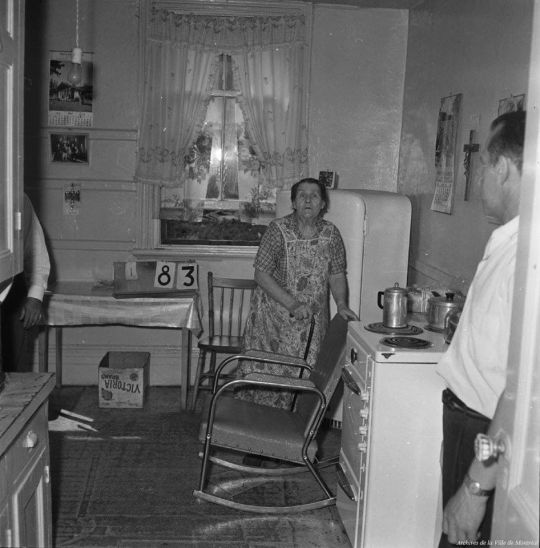Text
Une relation cruelle entre plomb et pauvreté

As seen in Le Devoir
By Brigitte Tousignant and Lea Sabbah
Les personnes vivant dans des municipalités rurales défavorisées courent davantage des risques d’être exposées au plomb dans l’eau potable que les habitants des villes mieux nanties, révèle une étude menée par des chercheurs de l’Université Laval. L’application des nouvelles recommandations de Santé Canada, qui a récemment abaissé la concentration maximale acceptable de plomb dans l’eau potable, risque de faire pression sur les autorités et les forcer à sortir leur portefeuille pour résoudre ce problème, qualifié d’injustice environnementale.
« C’est une injustice environnementale parce que les populations les plus défavorisées ont accès à un environnement moins sain que les populations plus favorisées […] C’est comme le fait d’être exposé à un air plus pollué », déplore Ianis Delpla, chercheur principal de l’étude et membre du Centre de recherche en aménagement et développement (CRAD) de l’Université Laval. L’étude publiée en 2015 est complètement passée sous le radar médiatique, en pleine crise de l’eau potable à Flint, au Michigan.
Les autorités fédérales et provinciales savent depuis longtemps que les personnes à faible revenu sont particulièrement à risque de boire une eau polluée par le plomb, et ce, peu importe où elles habitent. Cette étude vient donc confirmer cette iniquité à l’échelle des municipalités.
D’après l’étude, les communautés démunies présentent 33 % plus de risques de boire de l’eau contenant des concentrations de plomb supérieures à la norme de 5 parties par milliard (ppb) que les communautés des municipalités plus riches. 26 % des municipalités défavorisées ne traitent aucunement leur eau, contre 15 % des municipalités riches.
Les chercheurs — Ianis Delpla, Alexandre Lebel et Manuel Rodriguez du CRAD, Patrick Levallois de l’Institut national de santé publique (INSPQ) et Tarik Benmarhnia de l’Institut des politiques sociales et de la santé de l’Université McGill — se sont servi des données de recensement de Statistique Canada pour créer un indice de défavorisation matérielle qui regroupe le niveau de scolarité, l’emploi et le revenu des résidents de près de 600 municipalités.
À partir de cet indice, M. Delpla et son équipe ont subdivisé les municipalités en quatre groupes, allant des plus riches (premier quartile) aux plus pauvres (quatrième quartile), ce qui leur a permis d’observer une corrélation entre le degré de défavorisation, les traitements ajoutés à l’eau potable et le taux de deux contaminants, dont le plomb.
En croisant ces données avec celles du ministère de l’Environnement obtenues en vertu de la loi sur l’accès à l’information, l’équipe du Devoir et de l’Institut du journalisme d’enquête de l’Université Concordia a pu évaluer l’ampleur du problème de plomb dans les municipalités défavorisées. Selon les chiffres du ministère, 96 municipalités ont rapporté des résultats excédant l’ancienne norme québécoise de 10 ppb entre 2015 et 2018. Dans cette liste, une dizaine se classent dans les troisième et quatrième quartiles de la présente étude. À titre d’exemple, en 2017, les petites municipalités de Saint-Roch-de-Richelieu et Saint-Germain — se situant dans le troisième quartile — ont déclaré des niveaux élevés pour le plomb, soit respectivement 360 ppb et 245 ppb. Au sein des communautés les plus défavorisées, on retrouve La Martre (43 ppb), Chandler (49 ppb), Girardville (49 ppb) et Rivière-Bleue (92 ppb).
Ton statut socioéconomique a une influence sur ton taux sanguin, et cette population se trouve généralement dans de vieux quartiers où l’on repère des entrées de service de plomb
— Michèle Prévost
« Avec les nouvelles normes, nous ne pouvons prédire comment se comportera notre réseau », peut-on lire dans un courriel transmis au Devoir par un porte-parole de la municipalité de Rivière-Bleue, qui précise que « bien évidemment s’il s’avère que nous ne respections pas la norme et que des sommes importantes doivent être investies, une aide gouvernementale sera la bienvenue autant pour les municipalités que pour les résidents eux-mêmes ».
Un problème répandu
Cette inégalité ne se limite pas aux zones rurales. À Montréal, une étude du Centre hospitalier universitaire (CHU) de Québec de 2016 a démontré que les niveaux de plomb sanguins étaient considérablement plus élevés chez les enfants de cinq ans et moins d’origine étrangère et dont la mère était au chômage et ne possédait qu’un diplôme de niveau secondaire ou inférieur. Selon l’étude, ces facteurs socioéconomiques ont une influence sur l’association entre les niveaux de plomb dans le sang des jeunes enfants et l’exposition au plomb par l’eau provenant du robinet.
Déjà en 2013, le gouvernement fédéral statuait à la lumière des connaissances scientifiques que les « personnes économiquement défavorisées » étaient les plus exposées au plomb.
« Ton statut socioéconomique a une influence sur ton taux sanguin, et cette population se trouve généralement dans de vieux quartiers où l’on repère des entrées de service de plomb », explique Michèle Prévost, professeure d’ingénierie et titulaire de la Chaire industrielle en eau potable de l’École polytechnique de Montréal.
La carte interactive du Devoir présentant les zones les plus touchées par la présence de plomb en fait la preuve. Mercier–Hochelaga-Maisonneuve et le Sud-Ouest y figurent parmi les arrondissements les plus pauvres et les plus exposés à ce métal neurotoxique dans l’eau. D’autre part, le Vieux-Montréal et Griffintown, des arrondissements plus riches, sont les moins touchés par cette problématique.
Besoin d’un soutien financier
Québec ayant annoncé l’adoption de la norme de 5 ppb recommandée par Santé Canada, les municipalités pourraient faire face à des coûts supplémentaires pour gérer le problème. Pour M. Delpla, le gouvernement devrait offrir une aide financière à chaque municipalité aux prises avec un problème de plomb. « Il y a différents fonds provinciaux qui peuvent servir d’outil pour limiter ces inégalités de traitement, qui peuvent mener à des différences. »
Une opinion partagée par la Ville de Montréal. Juste avant le dévoilement du nouveau plan d’action de la Ville le 23 octobre, le directeur général, Serge LaMontagne, a écrit à trois ministères (Environnement, Santé et Affaires municipales) pour demander une aide financière dans ce dossier. La Ville évalue à plus de 600 millions le montant nécessaire pour éliminer toute trace de tuyaux en plomb sur son territoire. La Ville a d’ailleurs indiqué que de 2006 à ce jour, elle estime avoir investi 151 millions de dollars dans le remplacement de 21 000 entrées de service de plomb.
« Il demeure que [la Ville] ne peut être, seule, tenue responsable de la présente situation », peut-on lire dans la lettre envoyée aux ministères. Dans un courriel transmis au Devoir le 7 novembre dernier, la Ville dit qu’il est trop tôt pour un retour des ministères et que les suivis de la demande sont en cours. Rappelons que Montréal compte faire 100 000 dépistages au cours des trois prochaines années, fournir des filtres aux familles défavorisées et remplacer toutes les entrées de service de plomb — tant dans les domaines public que privé — d’ici 2030.
« [Certains propriétaires] ne voudront peut-être pas dépenser 5000 $ pour changer leur entrée de service de plomb. Ils n’ont pas forcément les moyens », fait remarquer Mme Prévost.
Il aura fallu 12 ans avant que la Ville réalise que son plan de remplacement était en deçà de ses objectifs, d’autant que les résidents étaient réticents à devoir payer eux-mêmes pour le remplacement des tuyaux.
C’est la raison pour laquelle la mairesse, Valérie Plante, a annoncé que la Ville avancerait les coûts pour enfin régler le problème en entier. La facture sera par la suite envoyée aux propriétaires qui pourront payer par versements sur 15 ans.
« La Ville prend ses responsabilités. Pour plein de raisons, si les propriétaires ne le font pas, on va le faire à leur place, parce que c’est une question de santé publique […] C’est très ambitieux [comme plan et cela] pourrait même être considéré comme intrusif, mais je considère que si on veut éliminer à la source, il vaut mieux faire l’entièreté des travaux », a indiqué Mme Plante à notre équipe d’enquête, peu avant d’annoncer son nouveau plan d’action.
0 notes
Text
LEA'S LATE NITE QUARANTINE JAMS

As seen in CJLO Magazine
By Lea Sabbah
"COME THRU" - Joji
Joji — aka Filthy Frank, aka Pink Guy — established himself as our YouTube generation’s multifaceted early adopter, finally graduating to music in 2015 and dropping alt-hit after alt-hit on his debut EP. On Come Thru—from the 2017 drop Ballads 1— his croony, pseudo-falsetto performance makes for a pill-popping, late nite party jam whose hook truly comes thru.
"deep end" - Lykke Li
Swimming pool, swimming pool, swimming pool, swimming pool. I’m in it, I’m in it, I’m in it. Divin’ in it, divin’ in it. This infectious dream pop bop by Sweden’s very own Lykke Li. It quarantines itself into the cavities of your skull and builds a home, replaying on loop in your mind until you can’t remember the rest of the lyrics.
"Glimmer" - Tame Impala
Kevin Parker describes this stunning, metallic highlight as “A glimmer of hope, a twinkle. Fleeting, but unmistakable. Promising.” Crank the bass up! This cool house track is great for nighttime parties of one, complete with a Tatcha mask, a (small) glass of wine and maybe half a Xan.
"Resonance" - HOME
This track is found on every Simpson/Vaporwave YouTube video — but especially the one with Bart driving into the sunset (if you know, you know) — and sparks feelings of summer nostalgia, Mont-Royal nights and walks through La ville éphémère. Quarantine tip: fall into a YouTube rabbit hole of explanation videos on why the repetitive electro track is reminiscent of slick 80s synths and your favourite childhood ice cream place.
"PUFF LAH" - Kaytranada
Montreal’s favourite chill house beatmaker is at his best on "PUFF LAH", off the December 2019 EP, Bubba. While Kaytra can craft catchy alt-pop and R&B on the collaborative joints, he shines on his instrumentals, as evidenced by the 2018 Soundcloud drop, "Nothin Like U / Chances" — arguably some of his best. You can listen to the entirety of this 4-minute beat and it feels like a comprehensive song, even with its simple, repetitive sound.
"WAKING UP DOWN" - Yaeji
Boiler Room’s 2017 breakout electro K-pop composer and pro Drake-coverer is back with her first drop of 2020. She brings back mellow, chill house vocals and a beat perfect for a late night creative sesh. The pop-rap track is reminiscent of Tumblr favourite, raingurl, but with more anime.
"Shimmer" - Fabiana Palladino
This ultra-lovable track has all the basics of a cool, 80s-inspired alt-pop joint — glistening synths, a subtle bassline, breathy vocals and an anti-establishment message. Listen out for the muted snares and glittery reverbs at the start of the song, establishing the little-known Paul Institute vocalist far ahead of the competition. Fabiana, sweetie, if you’re reading this, we need new music in 2020!
"So Heavy I Fell Through the Earth" (Art Mix) - Grimes
If you haven’t developed a Grimes obsession after February’s Miss Anthropocene drop by Canada’s weirdest electro anti-pop McGill alumni, you’re not living. Claire Boucher, Vancouver’s very own Enya, describes the track as an ode to getting pregnant with genius-slash-ponzi-schemer, Elon Musk - and the ego death that comes with it.
"Blood" - Prince Josh (ft. LA Timpa & Yves Jarvis)
Don’t sleep on The 6ix’s Prince Josh. The producer, songwriter and DJ’s downtempo, instrumental hip-hop, interlaced with hypnotic sound and D&B stylings (2020’s hottest trend in music) is perfect for late night eats and drinks with friends via FaceTime.
"Norton Commander (All We Need)" - Men I Trust
MTL’s fave indie-pop band is at their best on Norton Commander (All We Need), a chill, bass-heavy track perfect for winding down with Emma Proulx’s vocals serenading you to sleep. What does the title mean? We’ll have to ask them over drinks at Le Ritz.
"Gold Teeeth" - Blood Orange (ft. Project Pat, Gangsta Boo & Tinashe)
Dev Hynes’ R&B brainchild, Blood Orange, wrapped up a big year in 2019 with the mixtape Angel’s Pulse, an eclectic, genre-defying collection of tracks that reminds you of your favourite early-00’s R&B. The collabs are where Blood Orange is at their best, with Gold Teeth being the tape’s magnum opus.
"DHL" - Frank Ocean
Frankie is in his prime on DHL, the low-key, chill vibe late night track about ramen noodles and a DHL package that’s coming soon. We need Frank Ocean raps.
"12.38" - Childish Gambino
Thank God for Donald Glover’s haphazard 3.15.20 album drop, blowing the rest of March’s music releases out of the water. On "12.38", Gambino raps about a love interest that gives him some shrooms, using 3-Stack’s Vibrate under a sensual falsetto and some voice acting. The variegated track takes you on a journey that ends with trippy ad-libs and 21 Savage rapping about Lamborghini whippin’ and Popeyes chicken.
"Snowchild" - The Weeknd
Toronto’s MJ-esque R&B phenomenon blends 80s synths with R&B and catchy pop on his new drop, After Hours. On Snowchild, he talks about his journey to fame and his past life on the skreets of the 6ix. There’s some weird interlude with Bella Hadid that no one cares about. The futuristic, dream wave track is one of the best on the new drop, perfect for a chill weeknight at home.
"Sound of Rain" - Solange
You can’t have a late night playlist without a track from When I Get Home. Fight me on it. The slow, rat-tat-tat sound of "Sound of Rain" is perfect for washing away the pain of COVID-19.
"LOYAL (Remix)" - PARTYNEXTDOOR (ft. Drake & Bad Bunny)
This cutesy, tropical pop vibe of "LOYAL" finds the Mississauga singer with a new sense of sweetness, accompanied by fellow fuckboy 6ixer, Drizzy. And our little angel, Bad Bunny. If you don’t live under a rock, you’ve probably been saying “You’re my bEeEeEeEeEeSt friend” for the last few weeks.
"After Hours" - The Weeknd
The perfect after hours bop. Sex, drugs and melancholy — where Abel’s at his best. We don’t want to see you in a healthy relationship. Please give us painful, dark Glass Table music.
"Fukk Sleep" - A$AP Rocky (ft. FKA Twigs)
The run-of-the-mill trap beat on Fukk Sleep - off of Rocky’s mediocre 2018 drop, Testing - makes it one of the most catchy tracks on the album, made complete by FKA Twigs’ tittering, high-pitched ramblings. The video for this track finds the pair running wild through NYC, breaking into a bodega and a Chinatown store. If you’re up at 4 a.m., quarantined on a Wednesday with nothing to do, this track takes you there.
"Hold On, We're Going Home" - Drake (ft. Majid Jordan)
Our baby daddy, our toxic, unstable but romantic ex, whining at his best on a track we all know and love. A cute reminder that If we just Stay Home™ and stay healthy, we can all get through this weird, apocalyptic reality.
"NOTHING LESS" - PARTYNEXTDOOR
The first track to PND’s new drop is the perfect outro for a late night music sesh, its dark hip-hop beat so easy on the ears that you almost forget about his low-key vocal chops. A quarantine track to remember.
Check out Lea's Late Nite Quarantine playlist now!
6 notes
·
View notes
Text
Here Are The Rules On Travel In Quebec If You Live In A Red Zone

As of 12:00 a.m. October 1 in select regions, new red zone rules in Quebechave come into effect. The restrictions include new limits on gatherings, travel and any potential protests.
In a press conference on September 30, Premier François Legault outlined what the new rules mean for travel between regions.
The written rules state that interregional travel from a red zone to a zone with a different alert level (green, yellow or orange) is "not recommended," save for essential purposes.
But residents aren't allowed to participate in activities in other areas that have been banned in their own region.
"What is illegal in the red zone is illegal if you go to another zone," Legault said.
Red zone residents who engage in such activity in non-red areas could get a fine between $1,000 and $6,000.
And while the government isn't placing the burden on restaurant owners to check the IDs of restaurant-goers in their region, police are authorized to ask for your identification at any time.
"When we live in the red, we try to stay in the red, we try not to expose people in other regions and we avoid becoming a risk there, or a potential vector of contagion elsewhere than at home," Guilbault said.
0 notes
Text
Grimes Got Over $90,000 In Funding As A Canadian Artist & People On Twitter Have Questions

By Lea Sabbah
You probably know Grimes, the Juno Award-winning alt-pop artist who came up in Montreal and whose baby daddy is tech billionaire Elon Musk.
But you might not know she received $90,525 in financial support this year from FACTOR, a non-profit that funds Canadian musicians, partially through the Department of Canadian Heritage.
A recent Twitter thread by Niko Stratis, a Toronto-based consultant & artist manager, reveals that this has some folks raising eyebrows.
She doesn't live in Quebec
Why are people upset?
The applicant listed on the fund recipient list that includes Grimes' name is Quebec-based Crystal Math Music Inc.*
Grimes, herself, does not live in Quebec.
According to news reports, she recently bought a home in Pasadena, California where her boyfriend, Musk, reportedly lives.
It's also the state where their baby was born.
For all intents and purposes, Grimes doesn't live in Quebec or even in Canada anymore.
She doesn't need the money
Twitter users also pointed out that the money could have gone to marginalized, or struggling Canadian artists who do reside here.
Grimes' net worth is $3 million, according to CelebrityNetWorth.com.
"It’s not right that she’s taking in this much funding, and I know it’s hard for a lot of Canadian artists to see and hear and know that they are passed over for established rich artists and businesses," wrote Stratis.
FACTOR: She met eligibility criteria
FACTOR's list of funding recipients is publicly available on its website, and it includes some big names in the Canadian music industry, though many — such as The Weeknd — stopped receiving funding in recent years, possibly correlating to amassing more fame and wealth.
A communications manager for FACTOR, Karina Moldovan, told MTL Blog that it was Grimes' record label rather than Grimes who applied for and received the funding granted.
Moldovan said Crystal Math Music Inc. "met eligibility requirements" for the Comprehensive Music Company program, which is a "full-length sound recording program accessible to eligible record labels."
She also explained that "the eligibility requirements for FACTOR do not require Canadian citizens to live in Canada. Various artists who maintain Canadian citizenship live abroad and access FACTOR programs."
"FACTOR’s mandate is to provide assistance toward the growth and development of the Canadian music industry [...] with a focus on commercial success. In this way, FACTOR greatly differs from an arts council and should not be regarded as such," she said.
A bigger conversation is taking place on Twitter
Even though Grimes meets eligibility criteria, the allocation of these funds is raising questions on Twitter about how resources are distributed to Canadian artists.
Stratis' initial tweet has more than 500 likes.
By comparison, Montreal's Kaytranada received $20,000 from FACTOR this year.
"That amount of $ going to an established successful artist while there are so many struggling artists living HERE that are rejected or given tiny tiny grants because of their factor tier rating," tweeted Breanna Johnston, who makes music as Pallas Athene.
"My mind was blown at what that $$ could have done for someone else..."
0 notes
Text
Montreal Women Are The Stars Of This Powerful New Music Video For A Feminist Anthem
By Lea Sabbah

MissMe is a fast and animated speaker, her fervour palpable, as she talks of unicorn sharks, female empowerment and astrophysics. Well-known around the world for her art (even Madonna bought some), the Swiss-born, Montreal-based artist, or 'artful vandal' as she's called, is a notoriously fierce feminist who makes use of the female anatomy in her work — a display of her passion for gender equality.
The masked artist has been all over the world in her balaclava, letting her wheatpasting speak for itself in cities around the globe.
Now, for the first time, she's ventured into new territory: directing music videos, as a collaboration with the Montreal-band Random Recipe for their track "Hey Boy."
And she enlisted real Montreal women to star in the powerful production.

"Everybody on this project is from Montreal," MissMe told MTL Blog.
In the video, MissMe infuses her distinct flair into Random Recipe's lyrics.
The lyrics, seemingly directed at men, describe the everyday realities of women of all colours and creeds.
youtube
"So many women feel the same rage and feel the same pain in all those different backgrounds, different ethnicities and different ages," said MissMe.
"There is still something that [deeply] needs to change."
The video took Instagram by storm last week — and has now racked up over 70,000 views and hundreds of comments.
The cast of diverse, badass women of all ages, sexual orientations, ethnicities and genders paint a vivid portrait of solidarity across generations.

"We made it a duty to reach out to as many womxn we know, without limits or boundaries, and have them participate in this project collectively," said Random Recipe's Frannie Holder and Fab in an email statement.
The featured women, their faces free of makeup and unapologetic in expression, dance alongside MissMe’s 'vandals' in front of a black-and-white, graffitied backdrop.
"We told them, 'There will be no make up on set. We want you As You Are!' It was time that the public eye [saw] the image of Womxn as a strong, intellectual, brave, colourful [and] organic mosaic," said Holder and Fab's statement.

These strong Montreal women are putting our beloved city on the map in a progressive way.
And while that might be new territory for Random Recipe, they show no regret for their fearless messaging.
"We are rarely this explicit in our feminism in lyrics," their statement said.
"But if we are gonna write it black on white, we will be bold about it."
0 notes
Text
Montréal revoit son plan de lutte contre le plomb

La Ville de Montréal reconnaît l’échec de son plan de lutte contre le plomb dans l’eau et change sa stratégie de remplacement des canalisations. Elle obligera les propriétaires à remplacer leur partie des tuyaux en effectuant les travaux à leur place et leur enverra la facture, remboursable sur 15 ans.
« La Ville prend ses responsabilités. Si les propriétaires ne le font pas, on va le faire à leur place, parce que c’est une question de santé publique », a lancé la mairesse Valérie Plante en entrevue avec l’équipe d’enquête constituée du Devoir, de l’Institut du journalisme d’enquête de l’Université Concordia et de Global News.
Le nouveau plan d’action de la Ville en matière de gestion du plomb dans l’eau potable sera dévoilé mercredi matin.
Depuis le premier plan d’action adopté en 2006-2007, la Ville est à la recherche des tuyaux en plomb sous nos pieds pour en remplacer la partie publique, qui se rend jusqu’à la limite de la propriété privée des Montréalais. Il revient toutefois aux propriétaires de planifier et de payer le remplacement du côté privé.
« On se rend compte qu’il y a un très grand décalage entre la partie publique qui a été remplacée par la Ville, versus les entrées privées qui elles n’ont pas été remplacées. […] On a trouvé une solution [pour] s’assurer que la job soit faite », explique la mairesse qui est elle-même propriétaire d’un triplex dont elle loue plusieurs logements.
À l’heure actuelle, la Ville remplace tous ses tuyaux en plomb lors de travaux d’infrastructures et de réfection de chaussées. À l’avenir, si elle constate que l’entrée de service du côté privé est aussi en plomb, elle la remplacera en même temps. « Pour ce qui [a déjà été remplacé] dans le passé, si on n’a pas à retourner [faire des travaux], ce qui est prévu c’est qu’on va forcer les propriétaires, par règlement, à remplacer leur côté », précise Chantal Morissette, directrice du Service de l’eau de la Ville de Montréal depuis 2011.
De tels travaux peuvent représenter une dépense de 2500 à 5000 dollars pour un propriétaire, estime la Ville. C’est pourquoi elle offrira la possibilité de rembourser la facture sur une période de 15 ans. « On va devoir débourser en amont et il y aura un remboursement ensuite. C’est une décision importante qui va avoir un impact sur les finances de la Ville », admet Mme Plante, sans toutefois pouvoir préciser le budget qui sera alloué à un tel plan d’action.
D’après les données de la Ville depuis 2007, la moitié des entrées de services en plomb remplacées du côté public, ne l’ont pas encore été du côté privé. Très peu de propriétaires profitent des travaux effectués par la municipalité pour changer leur partie des tuyaux en même temps. Or, plusieurs études effectuées notamment par Polytechnique Montréal démontrent qu’un remplacement partiel des conduits en plomb ne diminue pas la concentration du métal dans l’eau, et peut même l’accentuer à court terme.
« Si on veut vraiment éliminer le problème à la source, il faut changer toute la conduite », insiste Valérie Plante.
Pourtant en 2014, cette même idée avait complètement été écartée. Lors d’une rencontre de la Commission permanente sur l’eau, une conseillère de l’époque, Elsie Lefebvre, avait avancé l’idée d’instaurer un règlement pour que les conduits en plomb, dans leur entièreté, deviennent une propriété du domaine public. Elle s’était alors fait répondre que « la Ville pourrait être poursuivie si le terrassement n’est pas refait de la même manière, comme à l’origine », peut-on lire dans le procès-verbal de cette rencontre.
« J’ai trouvé ça décourageant », se souvient Mme Lefebvre en entrevue avec l’équipe d’enquête. « C’est une absurdité complète parce que la Ville, avec des fonds publics — les taxes municipales des citoyens —, vient déjà faire les travaux jusqu’à la ligne de propriété privée. Il y avait vraiment eu un manque d’imagination juridique [pour trouver] une manière pour que tout le monde y trouve son compte sans avoir de poursuite et en réglant ce problème de santé publique. ».
« Aux États-Unis, plusieurs villes, et même des États, obligent désormais à faire uniquement des remplacements complets [des entrées de service en plomb] », explique de son côté Michèle Prévost, titulaire de la chaire industrielle en eau potable et professeure d’ingénierie à Polytechnique Montréal. « Ils sont allés en cour avec ça [parce que] ça pose des questions légales importantes d’aller sur le terrain d’un citoyen ».
Elle voit toutefois d’un bon oeil le plan proposé par Montréal. « Le faire à la place [des propriétaires], c’est bien. Le citoyen moyen ne sait pas comment faire. […] Si la Ville fait l’ensemble des travaux, elle va sûrement les faire à meilleur prix, parce qu’on n’a pas besoin de déplacer des équipes deux fois et ça va être le minimum de dérangement pour les citoyens. »
Recommandations tardives
Le plan d’action présenté par la mairesse s’est notamment appuyé sur les recommandations de la direction régionale de la santé publique (DRSP) de Montréal, transmises il y a quelques semaines à la Ville et révélées à l’équipe d’enquête la semaine dernière.
D’après le Dr David Kaiser, responsable de l’équipe en santé environnementale à la DRSP, « la situation à Montréal nécessite une action rehaussée, une action importante, pour régler la question [du plomb dans l’eau] connue depuis plusieurs années. »
La DRSP a ainsi recommandé à la Ville d’accélérer le dépistage et le remplacement des tuyaux en plomb. Elle a aussi conseillé d’offrir un moyen de protection aux Montréalais jusqu’à la fin des travaux qui prendront encore plusieurs années, considérant les milliers de remplacements à faire. « On juge que tous ceux qui vivent dans un bâtiment avec une entrée de service en plomb devraient avoir un filtre certifié pour réduire la teneur en plomb. On sait que certains ménages, pour des raisons financières ou autres, vont avoir plus de difficultés à adopter cette mesure volontaire là ; alors, on pense qu’un soutien est nécessaire », fait-il valoir.
Questionné sur la question de savoir pourquoi cette dernière recommandation n’avait jamais été proposée à la Ville auparavant, M. Kaiser a répondu que « la science est en évolution constante » et que l’évaluation des risques doit aussi prendre en compte le changement des habitudes de vie des citoyens. « On fait beaucoup la promotion de la consommation de l’eau et de l’économie de l’eau, ces dernières années. C’est moins plausible aujourd’hui qu’il y a dix ans de demander aux gens de laisser couler l’eau du robinet parce qu’on leur dit maintenant de l’économiser, ce qui est une bonne chose. Donc, ça nous amène à des recommandations différentes. »
Une idée que l’administration a décidé de suivre puisqu’un pichet d’eau doté d’un filtre certifié contre le plomb sera distribué aux résidents des logements où la présence de plomb aura été détectée, afin de les protéger le temps que les travaux soient terminés. La Ville fournira les premières cartouches du filtre, équivalant à une durée d’un an. Il reviendra toutefois aux résidents d’acheter de nouvelles cartouches par la suite.
Et pour permettre à tout un chacun de connaître la qualité de son eau, la Ville compte mettre en place un site Internet où seront publiés les résultats des tests de dépistage. « Les gens vont pouvoir taper leur adresse et ils vont voir s’ils risquent d’avoir une entrée de service en plomb », souligne Mme Morissette.
Dépistage massif
La Ville compte aussi appuyer sur l’accélérateur en matière de dépistage et de remplacement des conduits en plomb.
Depuis le premier plan d’action, 21 000 entrées de service en plomb — du côté public — ont été remplacées par la municipalité. À l’époque, celle-ci évaluait à 69 000 le nombre d’entrées de service en plomb sur le territoire montréalais. L’administration actuelle considère toutefois que 100 000 bâtiments doivent encore être testés, et la moitié d’entre eux pourraient bel et bien avoir des tuyaux en plomb. La Ville se donne d’ailleurs trois ans pour effectuer les tests de dépistage des bâtiments restants. L’année dernière, ce sont 10 000 dépistages qui ont été effectués à travers la ville.
L’administration Plante n’a par contre pas précisé si elle serait en mesure de respecter l’objectif initial, soit de retirer tous les tuyaux en plomb d’ici 2026.
Aux yeux de Michèle Prévost, c’est un coup à donner, si l’on considère le travail abattu ces douze dernières années et ce qu’il reste encore à faire. « C’est beaucoup de tuyaux, on n’en est même pas à la moitié, remarque-t-elle. Ça va prendre beaucoup de bras, beaucoup de personnels pour faire ça vite ».
CRÉDITS
Rédaction:
Annabelle Caillou, Brigitte Tousignant — Le Devoir Ian Down, Michael Wrobel — Institut du journaliste d’enquête de l’Université Concordia
Équipe d’enquête, Université Concordia:
Mia Anhoury, James Betz-Gray, Matthew Coyte, Miriam Lafontaine, Franca Mignacca, Lea Sabbah, Ayrton Wakfer
Reporters, Université Concordia:
Michael Bramadat-Willcock, Thomas Delbano, Elaine Genest, Adrian Knowler, Mackenzie Lad, Benjamin Languay, Jon Milton, Katelyn Thomas
Équipes de production:
Le Devoir: Véronique Chagnon (chef de projet), Lea Sabbah (stagiaire)
Institut du journaliste d’enquête de l’Université Concordia: Patti Sonntag (productrice et superviseure), Colleen Kimmett (coordonnatrice du projet), Fabio Luis Leon-Rosa (assistant éditorial)
Avec la collaboration de Global News
Produit par l’Institut du journalisme d’enquête de l’Université Concordia
0 notes
Text
Do you have lead in your tap water? What you can do to find out in Quebec

By Ian Down, Mackenzie Lad, Lea Sabbah, and Brigitte Tousignant from Concordia University and Megan Robinson with Global News
Editor’s note: This story has been updated to correct the approximate cost of testing water through an accredited laboratory without a discount for bulk tests.
Testing your water is the best way to learn whether there’s lead in it.
Older homes — those built more than 40 years ago — are at greater risk, because they are more likely to have lead plumbing. Montreal residents can check their home’s year of construction by consulting the online assessment roll, here. Assessments for Gatineau residents are available in a public database.
Lead was used as a material for water pipes until 1975, and in solder used to join pipes until 1986. Until 2014, faucets and hardware could contain up to eight per cent lead. Note that galvanized steel pipes can also leach lead into drinking water.
How do I check the pipes inside my home, to see if they are made of lead?
You can look at the pipes and solder joining pipes anywhere they are visible in your home. Lead is gray in colour, will not attract a magnet, and can be easily scratched with a knife or key. The scratches will appear silvery rather than coppery. You can also ask a plumber or home inspector to check for you.
The faucets need to be replaced. What should I look for when I’m buying new ones?
When buying a faucet, check whether it’s been certified as lead-free by a third-party certification body like the NSF International or the CSA Group. The faucet’s packaging should indicate that it complies with the NSF/ANSI 61 or NSF/ANSI 372 standards.
How do I get my drinking water tested for lead?
Montreal does not offer testing for free, unlike some cities, including Ottawa and Toronto.
Accredited laboratories can test your drinking water for lead for a fee which can cost upwards of $150 plus applicable taxes. A list of all of the accredited labs in the province can be found here.
To measure the maximum amount of lead your family may be exposed to, sample the water after a minimum six-hour stagnation period, during which no faucets or showers in the building have been used or toilets flushed — usually first thing in the morning or after returning from work. Lead leaching is highest in July and August, when the pipes are warmest.
For our investigation, we followed a three-sample method. After a six-hour stagnation, the kitchen tap was turned on at high pressure and the first sample collected immediately. The second sample was collected after the water had run for 45 seconds, and the third sample was collected after the water had run for two minutes.
Quebec’s environmental ministry oversees lead in the province and will direct you to your regional office, which can help interpret lead test results. Call their information centre at 1-800-561-1616.
Health Canada has set the maximum acceptable concentration of lead in drinking water at five micrograms per litre, or five parts per billion.
Scientists agree there is no level of lead that is considered “safe” and Health Canada recommends reducing levels as much as possible. (Lead exposure, even at low levels, is especially risky for fetuses, babies and young children, because it interferes with brain development.)
If you use the three-sample method described above, the results of the first sample may indicate if lead is leaching from the faucet or plumbing. The second sample is intended to measure if lead is leaching from the service line. The third sample may indicate if lead is leaching from the water main.
Is there anything I can do right away to reduce my family’s exposure to lead?
A water filter certified for lead should remove lead to undetectable levels.
Make sure that lead is listed on the package, and look for filters certified by the International National Sanitation Foundation to the NSF/ANSI 53 or NSF/ANSI 58 standard. Install filters at all faucets used for drinking or cooking. Be sure to replace the cartridges regularly, as instructed.
I’m a renter, and I found out my drinking water has lead levels above Health Canada’s maximum acceptable concentration of 5 micrograms/L. What can I do?
The Civil Code of Quebec requires that landlords maintain minimum legal requirements with regard to maintenance, habitability, safety and sanitation, but there are no specific requirements with regard to lead in drinking water. Several tenants’ rights groups we contacted in the province told us they had not encountered any complaints or concerns about lead plumbing in rental properties, and were unsure about how tenants might proceed with such concerns.
Montreal
What about the service line? Is it possible for me to check on whether it’s made of lead?
The city of Montreal keeps track of lead service lines (LSLs) on the public side, and is responsible for replacing them. According to city records, as of 2018, there were approximately 52,791 LSLs in Montreal proper. The city does not inform residents if they have an LSL on the public side, but does inform residents when they are replacing LSLs on a street.
Here are the boroughs and demerged cities on the Island of Montreal that confirm having lead service lines underground: Ahuntsic-Cartierville, Anjou, Côte-des-Neiges-Notre-Dame-de-Grâce, Côte-Saint-Luc, Hampstead, Lachine, Lasalle, Mercier-Hochelaga-Maisonneuve, Montréal-Est, Montréal-Nord, Montréal-Ouest, Outremont, Plateau-Mont-Royal, Rivière-des-Prairies, Rosemont-Petite-Patrie, Saint-Laurent, Sud-Ouest, Verdun, Ville-Marie, Villeray-Saint-Michel-Parc-Extension, and Westmount.
The city does not keep records of known LSLs on private property, and homeowners are responsible for the section of service line on their property. To check your service line, look for the pipe entering your home, in your basement, garage or crawl space. If you have a water meter, check the pipe feeding into the meter from the ground. You can do a visual inspection for lead, as described above.
You can also ask a plumber or home inspector to check for you.
If you are replacing a lead service line on the private side, you can email the city at [email protected] to request they change the service line on the public side. The city recommends directing all inquiries about lead service lines to this email address.
The service line needs to be replaced. What should I do?
If you have a lead service line on the public side and think it should be replaced, you can fill out this form and send it to [email protected] make a request.
City records obtained through a freedom of information request indicate that of the 538 citizen requests made in between 2014 and 2018, the city replaced 54 per cent within two years.
If the city is replacing the public side of your lead service line, experts recommend replacing the private side, if it is also lead, at the same time. However, property owners are responsible for this cost, and in Montreal, there are no subsidies to help homeowners offset private-side lead service line replacement, as there are in Saskatoon and Halifax.
0 notes
Text
It’s Hard Out Here for a Pimp —and a Journalist of Colour

It’s hard out here for racially ambiguous People of Colour—like your girl—in the field of journalism. In a métier of permeating whiteness, trying to “get this money for the rent” still isn’t as easy as it should be for marginalized up-and-coming journalists.
If you didn’t catch the bitter truth in my wildly understated Three 6 Mafia reference, let me drop a barefaced fact in this bitch: the overwhelming majority of journalists across all Canadian media are white. It should not come as a shock that recently updated data to substantiate this thesis remains to be found. It’s no surprise that newsrooms and other organizations are not pushing for data on racial diversity to be presented, mostly due to the simple fact that saying the taboo out loud is bad juju.
One of the extremely limited, more recent datasets on diversity in journalism, published in 2010 by CBC/Radio-Canada, showed that non-white minorities made up eight per cent of its reporting staff—and in a 2004 publication by the Canadian Task Force for Cultural Diversity on television news, visible minorities accounted for just over 12 per cent of Canadian anchors.
(If you’re reading this, it’s too late for righteous touting about Mitsumi Takahashi as the bastion of diversity in newsrooms.) In the same report, the organization found that minorities made up under nine per cent of reporters in English-language news. Before the Task Force’s report was published, the lone reflection of journalistic demographics in Canada was a now heavily outdated study from Université Laval in 2000, which found that 97 per cent of journalists at the time were white—97 per cent! This ain’t that Off-White that white people love so much—that’s that white-white.
Unless you live in an acid-induced dreamland, it would be fairly reasonable to ascertain that this statistic has failed to drop by 50 per cent in 20 years—especially without newsrooms placing emphasis on ensuring that more People of Colour enter the workforce. Any less of an increase in employment opportunities for marginalized journalists would be laughable and impertinent.
If you’ve ever been concerned about the total lack of urgency and prominence placed on diversifying newsrooms, you may have heard the age-old excuse many editors love to bank on when being pressed on why they don’t hire more journalists of colour. “They’re just not applying,” they say. “Our applications from visible minorities are so low. We just can’t help it if white people apply!”
Any sensible public relations rep for a prominent news organization would state facts on this phenomenon to put themselves ahead of their competitors, but no news outlet has blatantly said what it claims to so desperately seek in its line of work—the hard truth.
The fact is, visible minorities remain particularly undriven to join the workforce of journalists in Canada because they do not see others that look like themselves in the news industry. Why would you pursue a career path in which you’d stick out amongst your vanilla-faced peers like Evander Holyfield’s gnarly, chewed-up ear?
To the nonbelievers: you don’t have to search far and wide to see the effect of whitewashed journalism in action. Take, for example, our very own journalism program at Concordia.
As I reach the bitter end of a nearly five-year undergrad in this program, having had journalism classes with most of the same 15 or 20 people over the course of my education, I can count the number of visible minority students and professors in my classes on my elongated, manicured nails. In fact, I don’t think I’ve ever had a racially marginalized journalism professor. It should be noted that no data is publicly available on student and faculty demographics at Concordia.
So what can news organizations and educational institutes do about our plight? Diversifying journalism should be a top priority for institutes that are training the future of Canadian news. So should publishing data on demographics to bring to light the absolute lack of diversity in journalism programs and in newsroom employees.
Public acknowledgment of this issue should not be avoided, but encouraged—People of Colour want to know what you’re doing differently than past leadership.
The reasons behind our sad existences as journalists of colour are discernible. Students are often pressured by their families or cultural norms to pursue specific degrees and careers. But the culture of journalism in Canada will not change until all journalistic bodies shift their focus to not only hiring journalists of colour, but reporting on issues that affect journalists of colour and purposefully representing minority groups even with a lack of marginalized employees.
Racial minorities represent an increasingly significant portion of our population, and their voices should be a priority that deserve to be heard—just as much, or, dare I say, even more than Andrew Coyne’s archaic, meaningless drivel that Canadian media salivates over.
0 notes